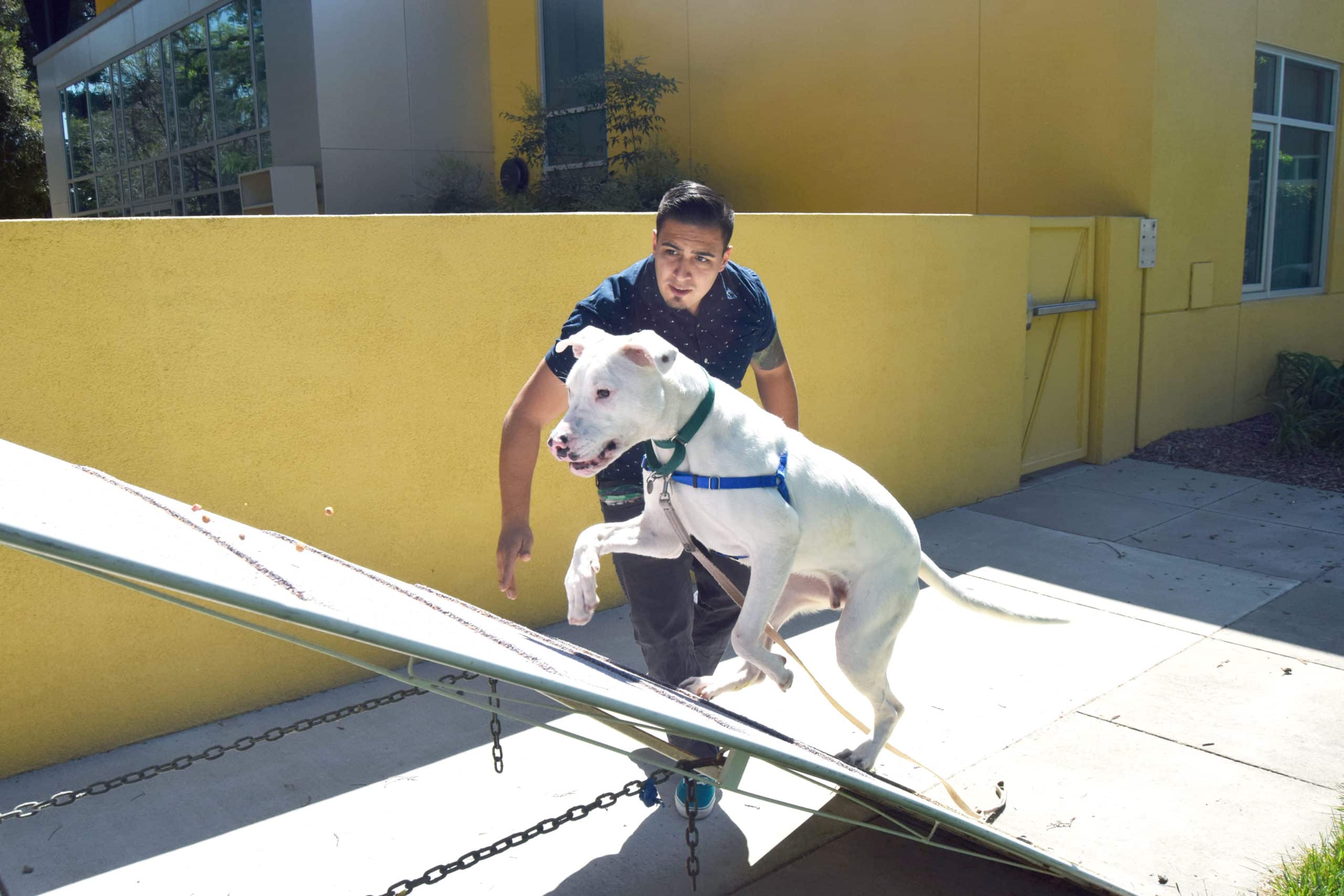Living with a fearful dog can be an entirely new experience for even long term dog owners. There are many degrees of fearful dogs and your dog may slide up and down the spectrum depending upon their skills and the situation they’re in.

Your dog might be fearful if:
- They move slowly or walk with their body low to the ground, like they’re sneaking into the room.
- They flinch, lean away, or duck when reached for. They may even tremble, lift their lip, or growl while they’re leaning away if that hand belongs to a stranger.
- They may stay in their bed or crate more often than not and might not be very active when they first come home.
- They might bark and back away from people or things, or bark until these scary things disappear.
- They might seem to always be ready to run away or freeze with tense muscles and wide eyes.
- They may urinate, make a high pitched yip, or whine when new things or people appear.
It’s more important to focus on what things make your dog uncomfortable than the “why” behind it.
There are many reasons that your dog might be fearful, it’s more important to focus on what things make your dog nervous and uncomfortable than the “why” behind it. Think about the wide array of things that might make you uncomfortable or anxious, when in these situations or spaces, what do you desire most? Is it to get away? Is it to make the thing/person go away? Is it to make the situation stop? Most of us would answer yes, all of the above. We may try different things like avoiding, moving away, telling the upsetting thing to leave or literally pushing it away from us. Fearful dogs often do all of these things, too. We call these behaviors “distance increasing behaviors.” These are behavior displays where the main goal is to create space between the dog and the scary thing. It’s important to think about our dog’s discomfort and avoidance in these situations and to try to be empathetic. Many times we want to coach our dogs through situations, explaining to them how impractical or illogical their fear is while pushing or encouraging them to move closer. Think of the many times our loved ones have tried to convince us that everything is “okay” and we’re “okay” — does it change our minds? Often, no.
It’s important to allow our dogs to take space when they need to, once they’re at a distance they feel is ‘safe’ then we can work on these situations and help them to feel comfortable enough to move closer.
How to Gain Trust and Confidence
A few helpful things to focus on when working with your dog to gain trust and confidence:
- Whenever possible, offer them choices: a choice to go through the door, a choice to put their leash on, a choice to sniff that bush, a choice to move away, or a choice to stay in place
- Reward your dog for making brave or good choices: With food, attention or space (move them away from the thing, if that’s what they want).
- Distance, duration, and intensity: In every situation there are these three knobs. Think of them like adjusters on your stereo. You never want to turn them all at once, it’ll overwhelm you and you won’t be able to hear the differences. Instead, turn one at a time. If you raise one, try lowering the others, and adjust them slowly so you can watch how your dog responds.
- Sometimes you can’t adjust a situation, but if you know it may be too much for your dog right now — try to avoid it whenever possible.
- Release the pressure: Loosen the leash, hold the door open, stand up straight instead of leaning over, drop the treat on the ground instead of offering it from your hand. Adding pressure, adds conflict — even if your dog really wants the thing. Too much pressure will slow the dog’s learning and may hurt their trust in you.
- Spend time building a savings account with them: Besides money, this account should hold trust. Trust looks, to dogs like positive and neutral experiences. Focus on building trust before you focus on changing their behavior. Once you have the trust, your dog will begin to adjust their behavior as they know you’ll support them.
- Plan ahead and adjust your surroundings to help your dog be successful and have a safe learning experience: This might look like asking the vet if your dog can wait in the car, instead of the lobby. Or adjusting your walking path or time of day to avoid the loud train or commuters
When to Seek Professional Help
Repeated exposure to things your dog finds overwhelming and scary, without your support will often result in a lack of trust to you. Either your dog will learn to display more behavior, or less behavior — but most often, the emotion behind the behavior does not improve. Less behavior might look like success, because it may make our lives easier, but it doesn’t make our dogs any happier or more confident. They are likely just learning that we aren’t listening. After some time, they may begin to take matters into their own paws, they may begin to display louder or more active behaviors, like barking, growling, snapping, showing teeth, lunging or biting.
If your dog has begun displaying these defensive behaviors, they’re asking for your help. Please speak with a certified professional that can help guide you and your dog towards successful communication.



